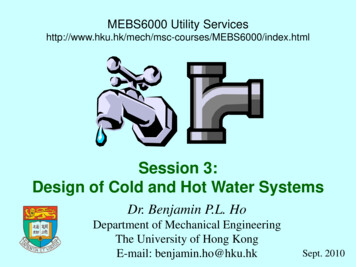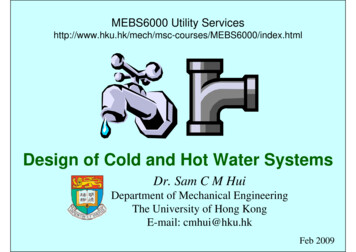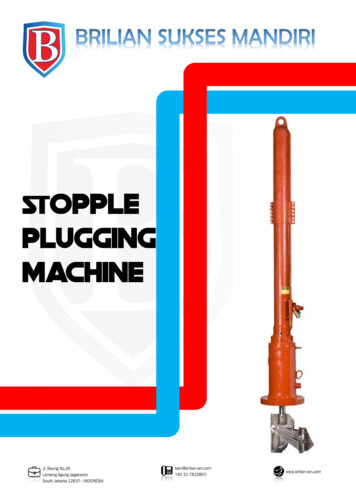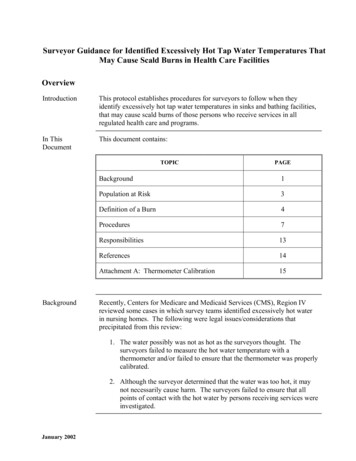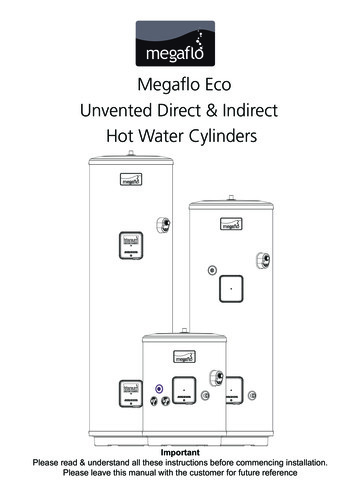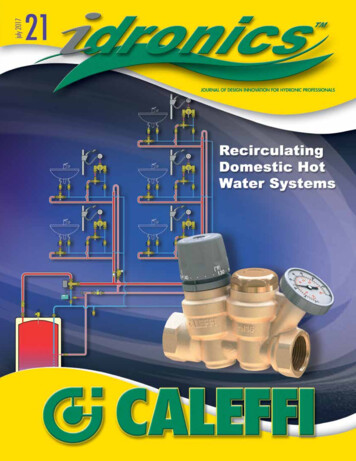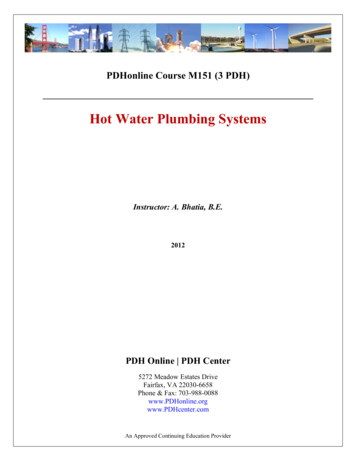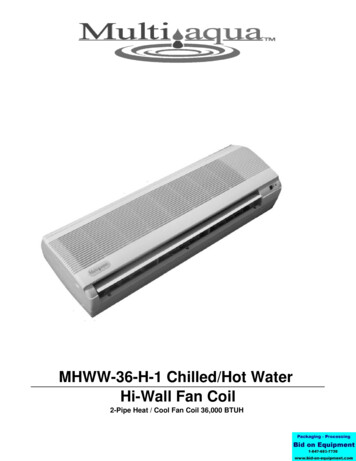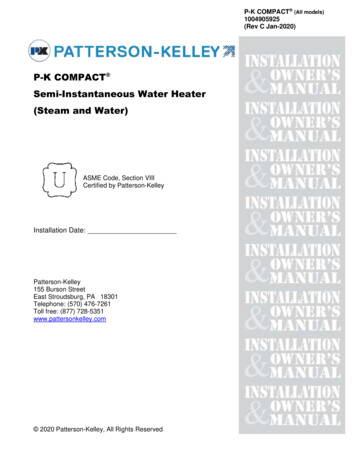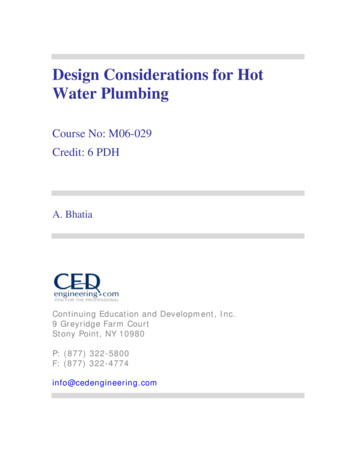
Transcription
Design Considerations for HotWater PlumbingCourse No: M06-029Credit: 6 PDHA. BhatiaContinuing Education and Development, Inc.9 Greyridge Farm CourtStony Point, NY 10980P: (877) 322-5800F: (877) 322-4774info@cedengineering.com
DESIGN CONSIDERATIONSFORHOT WATER PLUMBINGOverviewHeating water is typically the second largest use of energy in residential and commercialbuildings (after space heating and cooling). Despite its resource intensity, the hot waterdelivery system is seldom an area of significant focus when constructing a building. As aresult, many buildings today are built with poor performing, inefficient hot water deliverysystems that take minutes to deliver hot water to the point of use and waste largeamounts of energy and water in the process.The key to proper water heating system design is to correctly identify the quantity,temperature and time characteristics of the hot water requirement. The goal is to reducehot water wait time to 10 seconds or less, which is considered acceptable for publiclavatories. A wait time of 11 to 30 seconds is considered borderline and a wait time of 30seconds or more is unacceptable.This course will outline the design strategies that will deliver hot water as efficiently aspossible while meeting the increasingly challenging regulatory codes and userexpectations.
The course is divided into nine sections: PART – 1:Estimating Hot Water Demand PART – 2:Hot Water Generation - Water Heaters PART - 3:Sizing Storage Water Heaters PART - 4:Hot Water System Design PART - 5:Hot Water Plumbing System Installation & Layouts PART - 6:Sizing Hot Water Circulator and Piping PART - 7:Hot Water Temperature Control PART - 8:Facts, Formulas and Good Engineering Practices PART - 9:Regulatory Standards and Codes
PART -1ESTIMATING HOT WATER DEMANDAn adequate supply of hot water is a must for showers, kitchens, bathrooms, washingmachines, dishwashers and other appliances in homes, motels, hotels or commercialbuildings. Users expect hot water in adequate amounts, just as they expect lights at theflick of a switch. Improper sizing and design of hot water supply will invariably lead todissatisfaction and/or wasteful energy expenses.SIZING HOT WATER DEMANDSThe information on sizing the potable water (cold & hot water) is defined in the AmericanSociety of Heating, Refrigeration and Air Conditioning Engineers ASHRAE 1991Applications Handbook, the Uniform Plumbing Code (UPC), and the American Society ofPlumbing Engineers (ASPE) handbooks. All of these criteria take into considerationpeople use factors; people socio-economic factors, facility types, fixture types, and ahost of other factors.Before we proceed, let’s define few important terms:1. Fixture - A device for the distribution and use of water in a building. Example:shower, urinal, fountain, shower, sink, water faucet, tap, hose bibs, hydrant etc.2. Maximum Possible Flow –The flow that occurs when all fixtures are openedsimultaneously. Since most plumbing fixtures are used intermittently and the time inoperation is relatively small, it is not necessary to design for the maximum possibleload.3. Maximum Probable Flow –The flow that occurs under peak conditions for thefixtures that are expected to be in use simultaneously and NOT the total combinedflow with all fixtures wide open at the same time. The probability that all fixtures willbe used in a building at the same moment is quite remote. Generally, as the numberof fixtures increases, the probability of their simultaneous use decreases. Theplumbing system is normally designed on probability theory. If pipe sizes arecalculated assuming all taps are open simultaneously, the heater size and the pipediameters will be prohibitively large, economically unviable and unnecessary.Maximum probable flow is also referred to as “peak demand” or “maximum expectedflow”.4. Intermittent Demand – Plumbing fixtures that draw water for relatively short periodsof time are considered an intermittent demand. The examples include bathroom
fixtures, kitchen sinks, laundry trays and washing machines. Each fixture has its ownsingular loading effect on the system, which is determined by the rate of water supplyrequired, the duration of each use, and the frequency of use.METHOD - 1Estimating Hot Water Demand on Fixture UnitsThe fixture unit concept is based on theory of probability. The method is based onassigning fixture unit (w.s.f.u) value to each type of fixture based on its rate of waterconsumption; the length of time it is normally in use, and on the average period betweensuccessive uses. All the above factors together determine the maximum probable rateof flow. Table 1 lists the demand weights in “fixture units” as determined by the NationalBureau of Standards.TABLE 1Demand weights of plumbing items in ‘water supply fixture unit, w.s.f.uFixture or GroupOccupancyWater Closet (Flush Valve)Water Closet (Flush Tank)Pedestal Urinal (FlushValve)Stall or Wall Urinal (Flushvalve)Stall or Wall Urinal (FlushTank)Lavatory (Faucet)Bathtub (Faucet)Shower Head (Mix valve)Service Sink (Faucet)Kitchen Sink -1/21-1/22-1/42-1/4Private433Water Closet (Flush valve)Water Closet (Flush tank)Lavatory (Faucet)Bathtub (Faucet)Shower Head (Mix valve)Shower (Mix valve)Kitchen Sink (Faucet)Laundry Trays (Faucet)Combination Fixture(Faucet)WasherTotalBuildingSupply HW& CWCold Water(CW) only(Source: National Bureau of Standard Reports: BMS 65 by Dr. R. B. Hunter)HotWater(HW)only
From the Table above, the designer can assign fixture unit weights to the specificfixtures in his design. When these are added their total provides a basis for determiningthe maximum probable flow that may be expected in a water pipe. As a rule, separatehot and cold water demand can be taken as ¾ the total portable water demand; forexample, a lavatory faucet with a total demand of 2 w.s.f.u would be counted as 1½fixture unit on the cold water system, and 1½ fixture unit on the hot water. Supply pipingwould be calculated accordingly, while the total figure of the two fixture units would beused to design the drainage piping.Fixture Unit – Flow RelationshipOnce the total fixture count is obtained, the next step is to correlate this to the probableflow. In buildings with normal usage, the probability of simultaneous flow is based onstatistical methods derived from the total number of draw-off points, average timesbetween draw-offs on each occasion, and the time interval between occasion of use.There is a complex formula to get the probable water demand, however a simple chartand table are used to determine the probable water. The figure below shows theprobability of flow as a function of fixture unit count.Sum up the fixture units for your application; enter from the bottom on the X-axis; andread up to the curve that best fits the application. Then read to the left for the
corresponding gallons per minute (gpm) requirement. Pipe size can then be calculatedby referring to the pipe flowchart that depicts the relationship between the flow in gpm tothe pipe diameter in inches.ExampleEstimate the hot water flow rate for a small hotel building consisting of 52 flush valvewater closets, 30 flush valve urinals, and 40 lavatories.SolutionStep 1Determine the total fixture unit load for all the fixtures serviced by your water heaterapplication using the Fixture Units in Table 1.FixtureTypeQty.Fixture demandweightHot WaterColdWaterTotal (Hot &Cold)WC (flushvalve)52@ ories40@ 1.5606060 f/u730 f/uTotal750 f/uSince the hot water is required only at lavatories, the total fixture load is 60 f/u.Step 2Using Hunter Curves (Figure 1), enter the graph from the bottom at 60 fixture units andgo up to curve C. Then move to the left horizontally to read approximately 27 gallons perminute of hot water capacity required.CautionThe fixture count method is based on theory of probability. This method is consideredaccurate for large groups of fixtures but for smaller applications, this may yield
erroneous results. The reader is advised to use discretion and refer to the local codesand standards.Second, the flow probability as a function of fixture units will also vary with the type offacility and it depends on the usage time duration and other specific requirements. A100% simultaneous draw-off may occur in buildings, such as factory wash-rooms, hosteltoilets, showers in sports facilities, places of worship, and the like. In these cases, allfixtures are likely to be open at the same time during entry, exit and recess. Othermethods are discussed below.METHOD -2Estimating Hot Water Demand on Fixture TypesThe ASHARE applications handbook, Chapter 45, provides the hot water demand ingallons per hour based on the fixture types directly. This is a simplified approach thatsaves the effort of first estimating the fixture units, and then estimating flow against thefixture units, as explained above.TABLE 2Hot Water Demand per Fixture for Various Types of Buildings(Gallons of water per hour (GPH) per fixture @ 140 F)Fixture oolBasin (lavatoryprivate)22222222Basin washer1550150-50-1505020020-100-20-100Foot basin33123312-12Kitchen Sink1020-2030202020Laundry2028-2828--28Pantry Sink510-1010-1010Shower30150225757522530225Service -
Fixture oolHubbard Bath---600----Leg Bath---100----Arm Bath---35----Sitz Bath---30----Continuous FlowBath---165----Circular Wash Sink---20203020-Semicircular .4Storage nd Factor(Source: ASHRAE Applications Handbook, 2003, Chapter 45, Table 9)If a particular fixture or a specific building type is not listed above, the flow rate can beassigned based on engineering judgment, best practices historical data, or supplier’sinstructions.Notes:1. Note1: A Demand Factor is applied to calculate the Maximum Probable Demand,which is the rate at which the heater will generate hot water and is also termed as“the recovery rate or heater capacity”. A high demand factor will mean a higherrecovery rate or heater size.2. Note2: The storage volume of the tank needs adjustment for usable volume toaccount for the drop in temperature resulting from withdrawal of hot water andcontinuous entry of cold water in storage tank. The “maximum probable demand” isthus factored by the “storage capacity factor” to determine the “storage tankcapacity”.ExampleDetermine the heater and storage tank size for an apartment building having thefollowing fixtures.ItemQtyBasins:60 no.
Bathtubs:30 no.Showers:30 no.Kitchen sinks:60 no.Laundry tubs:15 no.SolutionFrom table below, estimate the possible maximum demand for the respective fixtures.ItemQty.Flow/unitTotal flowBasins:60 no. x 2 GPH 120 GPHBathtubs:30 no. 20 600 GPHShowers:30 no. 30 900 GPHKitchen sinks:60 no. 10 600 GPHLaundry tubs:15 no. 20 300 GPHPossible maximum demand: 2520 GPHMaximum Probable Demand: 2520 0.30 756 GPH --- (See Table 2,Note 1)Or heater capacity: 756 GPHStorage Capacity: 756 1.25 945 gal --- (See Table 2,Note 2)
METHOD - 3Estimating Hot Water Demand on Occupants/UnitsThe Method-2 provides the demands in gallons per hour for various types of fixtures andfor various types of buildings. However, it does not provide the time factor usage rate.For more realistic results, two basic determinations must be made:1) Maximum load (or hourly peak demand)2) Working load (influenced by duration of use)Maximum load - The maximum load of a water heater is the maximum amount of waterused daily per person per hour. It is also called hourly peak demand since the amount ofdaily water used is spread over several hours. The amount of water varies with style ofliving and type of building. To determine the size of the hot water heater for a building,consider the maximum hourly use and number of users.Working Load – Working load is influenced by the duration of that peak demand and isdefined as the percentage of maximum load expected under normal conditions in anygiven hour.Table 3 below is an empirically derived approach that relies on the historical actualmeasured data for specific building categories.TABLE 3Peak Hot Water Demands and Use for Various Types of BuildingsType of BuildingMaximum HourMaximum DayAverage DayMen’s Dormitories3.8 gal/student22 gal/student13.1 gal/studentWomen’s Dormitories5.0 gal/student26.5 gal/student12.3 gal/student20 or less6.0 gal/unit35.0 gal/unit20.0 gal/unit605.0 gal/unit25.0 gal/unit14.0 gal/unit100 or more4.0 gal/unit15.0 gal/unit10.0 gal/unitNursing Homes4.5 gal/bed30.0 gal/bed18.4 gal/bedOffice Buildings0.4 gal/person2.0 gal/person1.0 gal/personMotels: No. of UnitsFood Service Outlets:
Type of BuildingMaximum HourMaximum DayAverage DayType A – Full meal1.5 gal/max11 gal/max2.4 gal/averagemeals/hrmeals/hrmeals/hr0.7 gal/max6.0 gal/max0.7 gal/averagemeals/hrmeals/hrmeals/hr20 or less12.0 gal/apt80.0 gal/apt42.0 gal/apt5010.0 gal/apt73.0 gal/apt40.0 gal/apt758.5 gal/apt66.0 gal/apt38.0 gal/apt1007.0 gal/apt60.0 gal/apt37.0 gal/apt200 or more5.0 gal/apt50.0 gal/apt35.0 gal/aptElementary schools0.6 gal/student1.5 gal/student0.6 gal/studentJunior and Senior high1.0 gal/student3.6 gal/student1.8 gal/studentrestaurants &cafeteriasType B – Drive-in,grilles, luncheonettes,snack shopsApartment houses:No. of apartmentsschools(Source- ASHARE applications handbook, 2003, chapter 45, Table 7)ExampleDetermine the monthly hot water consumption for a 2000-student high school.SolutionRefer to Table 3, Average day consumption 1
Design Considerations for Hot Water Plumbing Course No: M06-029 Credit: 6 PDH A. Bhatia Continuing Education and Development, Inc. 9 Greyridge Farm Court Stony Point, NY 10980 P: (877) 322-5800 F: (877) 322-4774 info@cedengineering.com . DESIGN CONSIDERATIONS FOR HOT WATER PLUMBING Overview Heating water is typically the second largest use of energy in residential and
